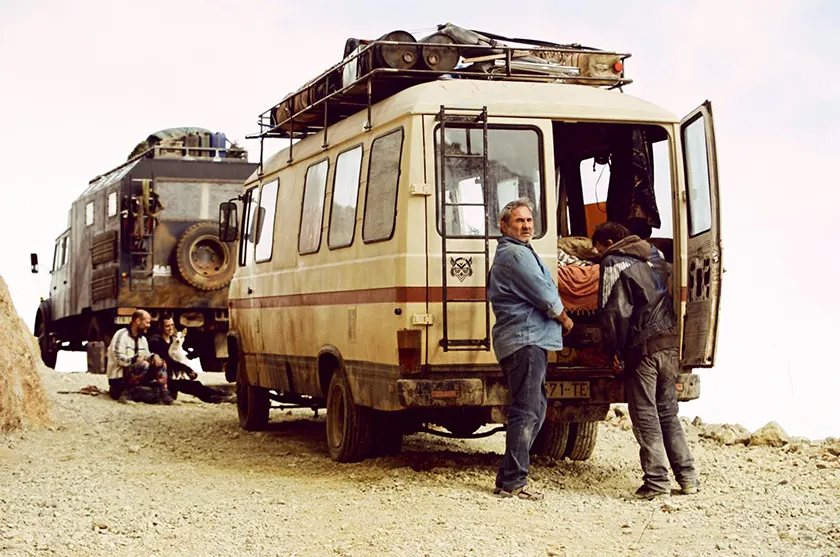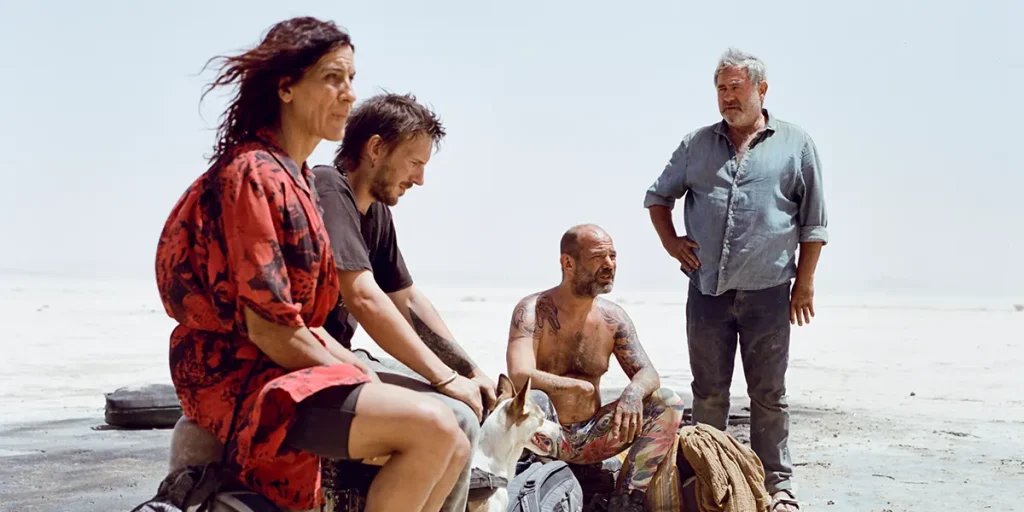Confrontational but contemplative, Oliver Laxe’s Sirât is a brilliantly energetic and well-crafted take on the long night of the soul.
Director: Oliver Laxe
Genre: Drama
Run Time: 120′
Cannes Premiere: May 16, 2025
U.S. Release Date: November 14, 2025 in select theaters; January 2026 nationwide
U.K. Release Date: TBA
Did you ever go to a festival or concert and make new friends? When the music stops, you promise to keep in touch, to meet again, maybe even go to other events together. Bonds of found family can be made at such events; even if they don’t last, they feel special in that moment. Sirāt, writer-director Oliver Laxe’s follow-up to the incendiary but hollow Fire Will Come, is a film about how to define family: by losing it, finding it, searching for it.
By the end of the film, seven people will be broken and bonded by their shared experiences, and that’s not a reference to anything they might have dropped at a festival. Family is expected to survive through thick and thin, but no trip at a festival can compare to the roadtrip being taken in Sirāt.
The title and opening text of the film offer our first warning. In Islam, the ‘siraat’ is the bridge between heaven and hell, over which all are doomed to walk on the Day of Resurrection. To the unfaithful, the bridge will be as sharp as a sword, and as thin as a hair. The characters who are about to embark on a journey in Sirāt are walking that fine line whether they realize it or not.
To be fair, when the film opens, Luis (Sergi López), his young son Esteban (Bruno Núñez) and their dog have already made some progress. Coming from Spain to the foothills of the Anti-Atlas mountains of southern Morocco, Luis is seeking out his missing daughter. She is a habitual rave-goer, but it’s a world about which Luis clearly knows very little (He’d have left his son at home for a start). López is well cast here; his doughy unshaven features are a long way off his best-known role as the sadistic army captain in Pan’s Labyrinth. Shorn of the power of a uniform, he is now a humble supplicant, preparing to brave whatever the gods throw his way in order to find his family.
Luis and Esteban encounter a grungy bunch of revellers who suggest the girl will be another rave not far away. Thus, the odyssey of Sirāt begins proper, with father and son being dragged from one lead to another, with their journey becoming increasingly fraught, and the landscape becoming more and more unforgiving. It’s a no-man’s-land somewhere between Godot and Sisyphus, but at least they have good company.
After their next rave is broken up by some form of military police (Like so many of Sirāt’s mysteries, who or what they are is kept ambiguous), the ravers from the previous party offer to bring Luis and Esteban to another rumoured rave further south in Mauritania. These party boys and girls, including Richard Bellamy’s one-armed Bigui and Jade Oukid’s pierced and robed Jade, have offered to help someone in need, and now they have to see if they can pass the tests that result. The increasing hardships that await this group on the trek south spin Sirāt off from a sweet tale of people coming together into full-on psychodrama, complete with screaming, blood loss and threats against dogs. Buckle in.
Laxe put together a similar dynamic with caravaneers walking a similar part of the world in his 2016 feature Mimosas. The characters in that film exercised caution as they were escorting a corpse, and feared the mountains’ wrath for their desecration. The revellers of Sirāt know no such inhibitions, ignoring the omens that Laxe and Santiago Fillol’s script puts in their way. From a river they can barely cross to a remote petrol station running dry, the fates are forever urging them to turn back. The locations are a mix of sandy wastes and rocky slopes, offering no shelter or shade.
Sirāt offers similar warnings to the viewer. The film opens with a rave being set up by a gang of burly sweaty men. The camera lingers over the speakers they’ve erected, as pounding techno beats slowly rise, as if emerging from the belly of the earth. From the hedonism of the ravers to the lingering unease radiating from the mountaintops, Sirāt’s energy is raw, almost primeval. Laxe’s omniscient direction and DoP Mauro Herce’s parched images are full of force, but it’s never haphazard. Temperatures, tensions and body counts rise, and they were doomed to do so from the start. Drone shots let us know that someone up above might be directing this foolhardy quest.

To say much more about the ongoing search for Luis’ daughter risks spoiling some surprises but, past a certain point, she threatens to become a Maguffin. She is the destination, but Sirāt is about the journey. The audience is right there with the characters, through the potential ennui of long days, to the unbearable unease of a final act that sees our unlikely caravan make a wrong turn into a man-made hell. As the time passes, the characters are forced to embrace the lunacy as they get stuck in a sandy rut. Jade puts on music and dances, her robe flowing in the wind. Her moves call to mind the nightmarish colour-sapped images of E. Elias Merhige’s Begotten, another film that reckoned with the Almighty and found he was not pleased.
Sirāt is a lot less pretentious than Begotten, but it is just as concerned with the corruption of the soul and the presence (or absence) of God. It just happens to have a thumping EDM soundtrack, set in a landscape where life is barely possible. Laxe knows van der Rohe’s maxim is true: God is in the details. You can’t take your eyes off Sirāt for a moment; you just might miss something important.
Sirāt: Movie Plot & Recap
Synopsis:
A father brings his young son to look for his daughter at a desert rave, but the journey takes many unexpected and extremely dangerous turns.
Pros:
- Masterful writing and direction from Laxe, with the energy of the plot hiding deeper thematic concerns
- A charismatic cast of memorable character
- A final act that’s among the most tense sequences in any film this year
Cons:
- Some may question if it’s nihilistic, with some moments that lapse into profound misery
Sirāt premiered at the Cannes Film Festival in competition on May 16, 2025. The film will be released in select U.S. theaters on November 14, 2025 and will have a wide theatrical release in January 2026.

